The Revolutionary Fusion of Gaming and Blockchain Technology
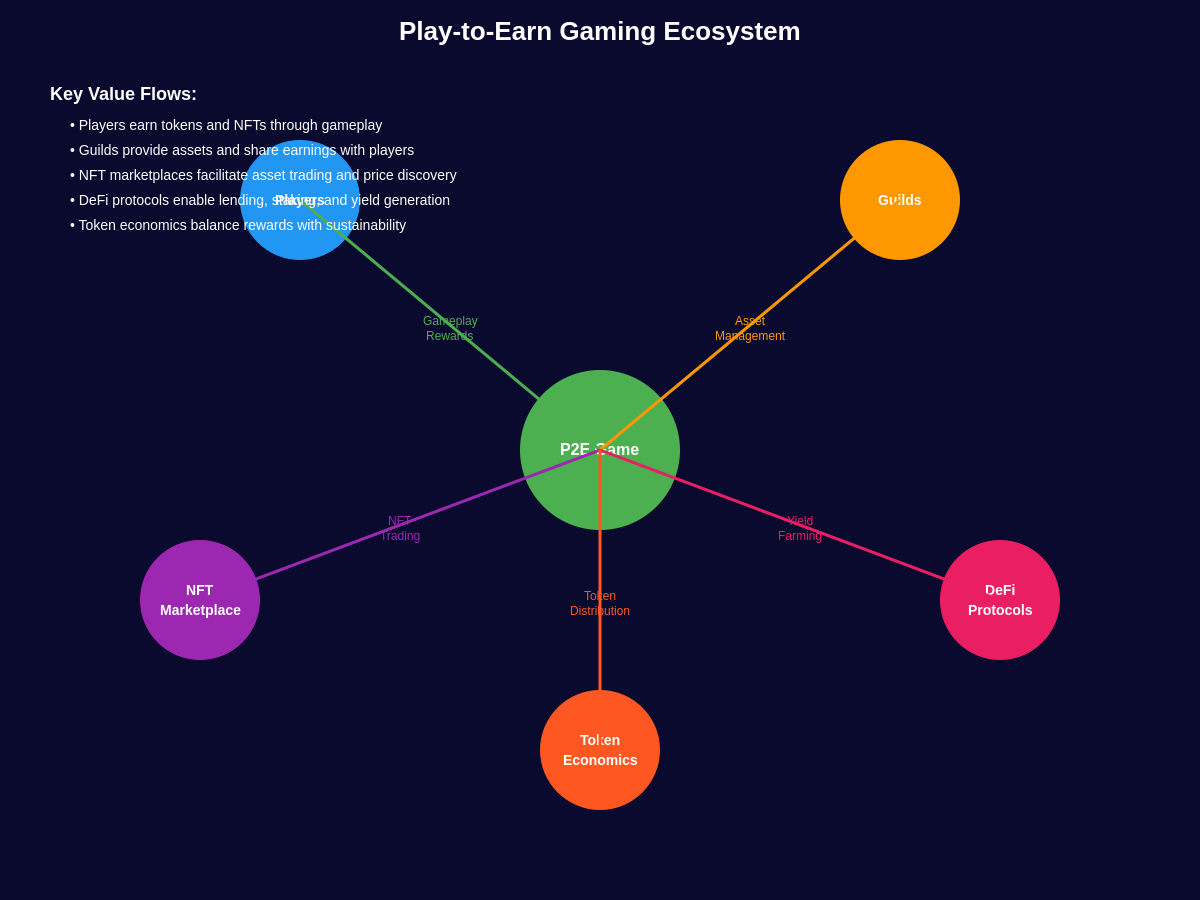
The gaming industry stands at the precipice of a transformative revolution that extends far beyond traditional entertainment paradigms. Gaming NFTs and play-to-earn models represent a fundamental shift in how players interact with virtual worlds, creating unprecedented opportunities for economic participation and digital asset ownership. This emerging ecosystem is reshaping the very foundations of gaming economics, transforming players from passive consumers into active stakeholders who can generate real income through their gaming skills and strategic investments in digital assets.
The concept of play-to-earn gaming has evolved from a niche experiment into a multi-billion dollar industry that attracts millions of players worldwide. Unlike traditional gaming models where players spend money on in-game purchases that have no real-world value, play-to-earn games enable participants to earn cryptocurrency tokens and NFTs that can be traded on open markets for real money. This paradigm shift has created new forms of digital labor and investment opportunities, particularly in developing countries where skilled players can earn substantial income through gaming activities.
Understanding Gaming NFTs and Their Unique Properties
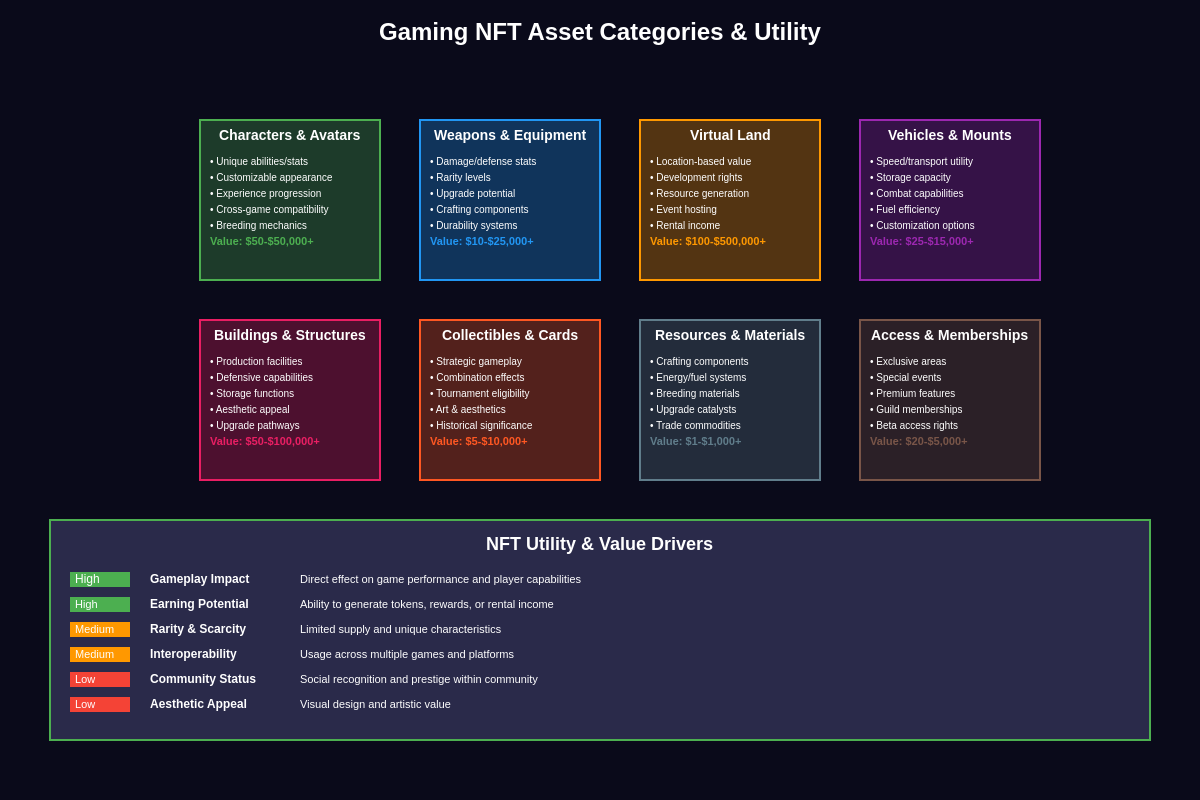
Gaming NFTs represent a new category of digital assets that combine the scarcity and ownership benefits of non-fungible tokens with the interactive utility of gaming items. These digital assets can take various forms, including character avatars, weapons, armor, land parcels, buildings, vehicles, and even entire gaming experiences. What distinguishes gaming NFTs from traditional in-game items is their blockchain-based nature, which ensures true ownership, interoperability potential, and the ability to transfer or sell assets outside the original game ecosystem.
The technical infrastructure underlying gaming NFTs relies on smart contracts that define the properties, behaviors, and ownership rights of each digital asset. These smart contracts operate on various blockchain networks, with Ethereum, Polygon, Binance Smart Chain, and specialized gaming blockchains like Immutable X and Ronin providing the foundation for different gaming ecosystems. The programmable nature of these smart contracts enables sophisticated game mechanics, automated reward distribution, and complex economic interactions between players, developers, and third-party service providers.
Interoperability represents one of the most compelling long-term promises of gaming NFTs, though current implementations remain limited. The vision of truly interoperable gaming assets would allow players to use their NFT weapons in multiple games, transfer character progression across different virtual worlds, or utilize land ownership rights in various metaverse environments. While technical and design challenges currently constrain full interoperability, projects like Enjin, The Sandbox, and Decentraland are pioneering approaches that demonstrate the potential for cross-game asset utility.
The Economics of Play-to-Earn Gaming Models
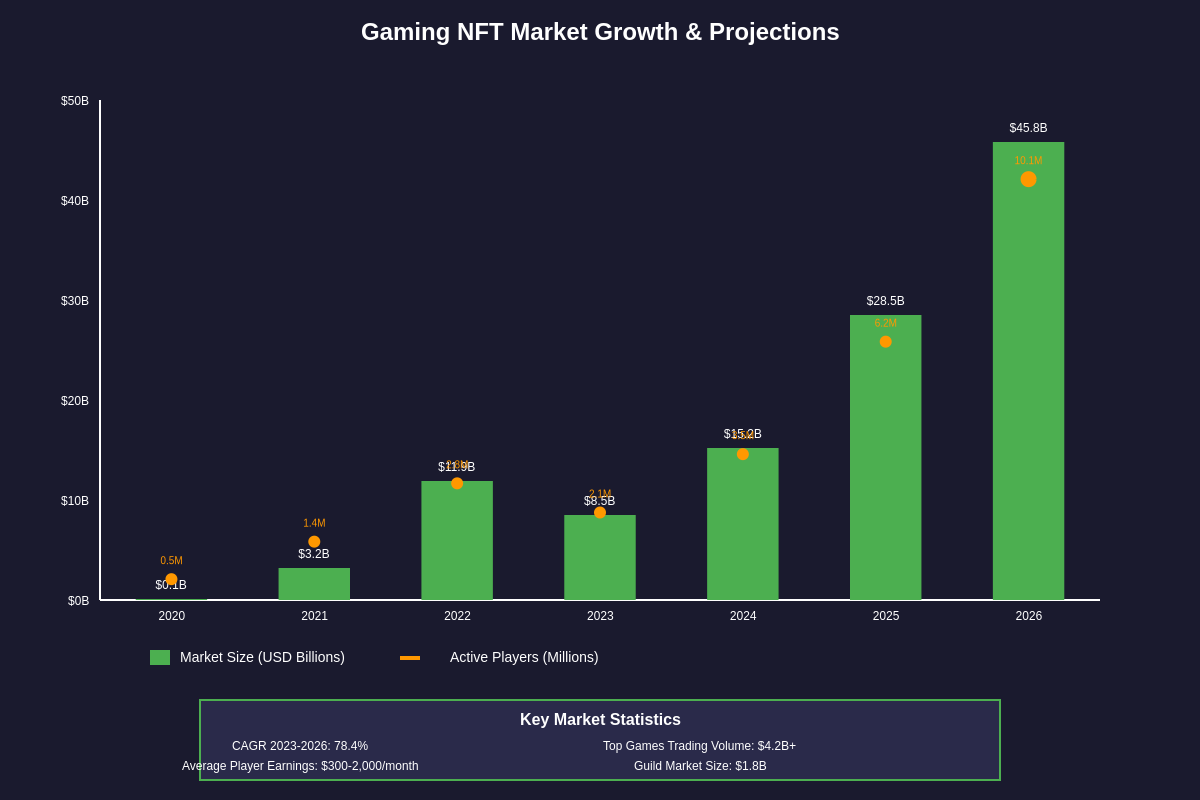
Play-to-earn economics fundamentally restructure the traditional gaming value chain by introducing token-based reward systems that distribute value directly to players based on their contributions to the game ecosystem. These economic models typically incorporate multiple token types, including governance tokens that provide voting rights and long-term value accrual, utility tokens used for in-game transactions and rewards, and NFTs that represent unique assets with varying degrees of rarity and functionality. Professional traders monitoring gaming token price movements and market dynamics can identify emerging opportunities in this rapidly evolving sector.
The sustainability of play-to-earn models depends on maintaining delicate economic balance between token generation through gameplay rewards and token consumption through various in-game mechanisms. Successful games implement sophisticated tokenomics that include token burning mechanisms, staking requirements, breeding costs, upgrade fees, and marketplace transaction taxes that create continuous demand for the game’s native tokens. These deflationary pressures must be carefully calibrated against inflationary forces from new player rewards and token generation to maintain long-term economic stability.
Guild systems have emerged as a critical component of play-to-earn ecosystems, providing organizational structures that enable collective investment in expensive NFT assets and coordinated gameplay strategies. Gaming guilds pool resources to purchase high-value NFTs like rare characters or land parcels, then distribute these assets to skilled players who generate returns through gameplay activities. This model has created new forms of digital capitalism where guild managers, scholars, and asset owners share revenues according to predetermined agreements that resemble traditional business partnerships.
Major Play-to-Earn Games and Their Impact
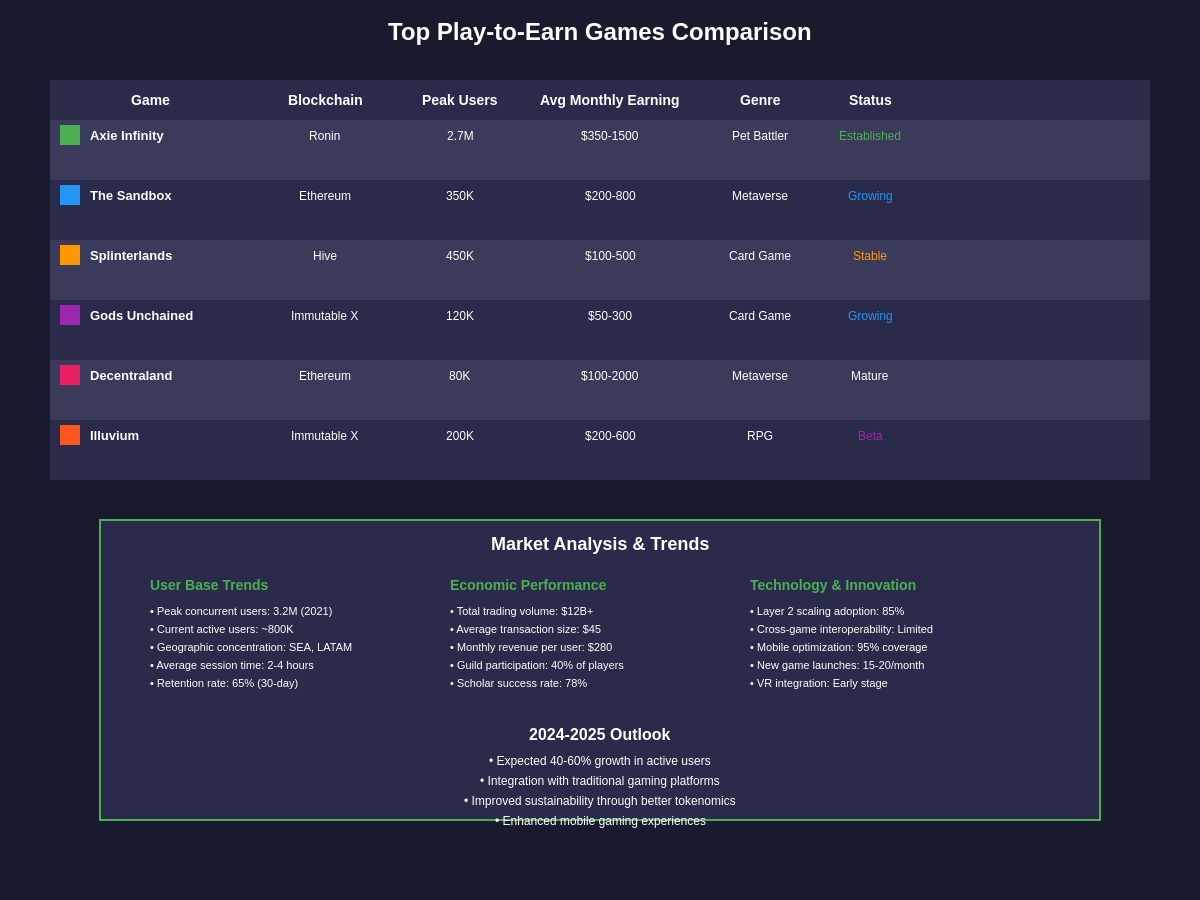
Axie Infinity pioneered the play-to-earn model and remains one of the most influential games in the space, demonstrating both the potential and challenges of blockchain-based gaming economics. At its peak, Axie Infinity generated over $1.3 billion in trading volume and attracted more than 2.7 million daily active users, primarily in the Philippines, Indonesia, and other Southeast Asian countries where players could earn more through gaming than traditional employment. The game’s scholarship system, where asset owners lend NFT creatures to players in exchange for shared earnings, created a new form of digital economic relationship that has been replicated across numerous other projects.
The Sandbox represents a different approach to play-to-earn gaming, focusing on user-generated content creation and virtual land ownership within a voxel-based metaverse environment. Players can purchase LAND NFTs, develop them with custom experiences and buildings, and monetize their creations through various mechanisms including event hosting, asset sales, and experience access fees. This model transforms players into virtual real estate developers and content creators who can build sustainable businesses within the game ecosystem.
Splinterlands has successfully implemented a play-to-earn trading card game model that combines strategic gameplay with NFT card ownership and tournament rewards. The game’s focus on competitive play and skill-based rewards has created a more sustainable economic model compared to some purely grinding-based play-to-earn games. Players invest in card collections, participate in ranked battles and tournaments, and earn rewards based on their performance and strategic decisions rather than simply time investment.
Guild Systems and Scholarship Programs
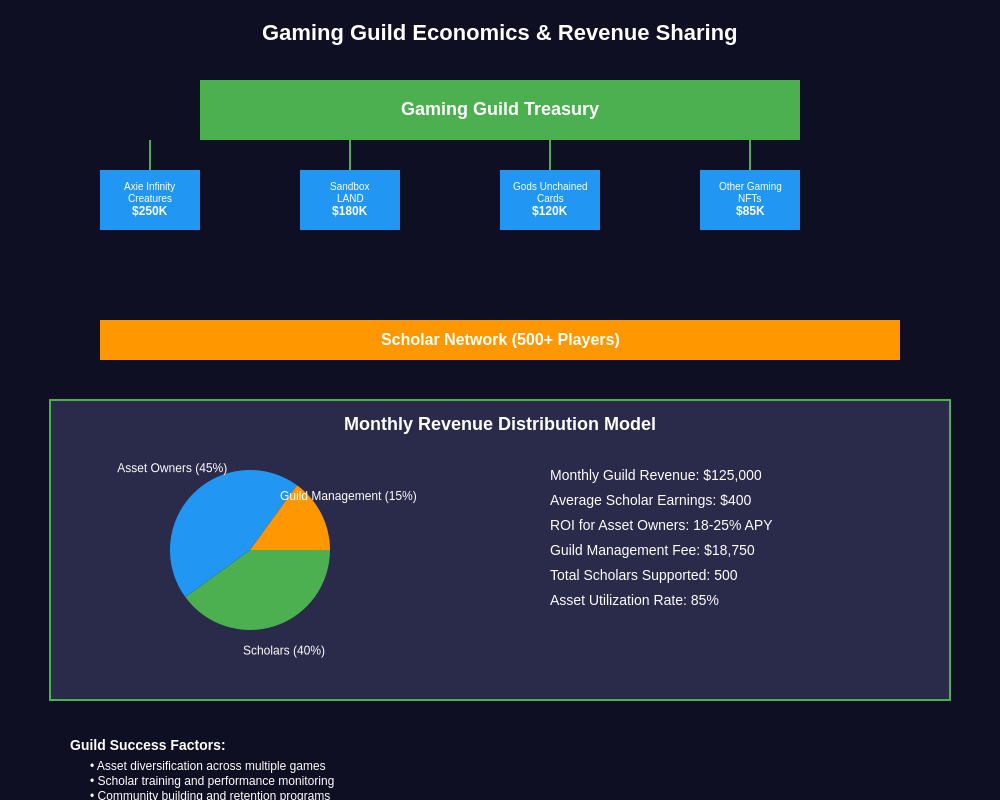
Gaming guilds have evolved into sophisticated organizations that function as investment funds, educational institutions, and professional development platforms for play-to-earn participants. These guilds typically maintain treasuries containing valuable NFT assets, provide training programs for new players, offer technological infrastructure including analytics tools and automated systems, and facilitate connections between players across different games and geographic regions. Market participants utilize advanced charting and analysis tools to evaluate guild performance metrics and optimize asset allocation strategies.
Scholarship programs represent a unique innovation in gaming economics, creating opportunities for skilled players without initial capital to participate in play-to-earn games by borrowing expensive NFT assets from investors. These arrangements typically involve three parties: asset owners who provide the initial NFT investment, scholars who play the games and generate rewards, and guild managers who facilitate the relationships and provide support services. Revenue sharing agreements vary but commonly allocate 30-40% to scholars, 10-20% to guild managers, and 40-60% to asset owners, creating incentive alignment across all participants.
The geographic distribution of play-to-earn participation has created interesting economic dynamics, with players in countries like the Philippines, Venezuela, Indonesia, and Vietnam able to earn above-average local incomes through skilled gaming activities. This has led to the emergence of professional gaming careers and educational programs focused on blockchain gaming, transforming how people in these regions view gaming from pure entertainment to legitimate economic opportunity.
Tokenomics and Reward Distribution Mechanisms
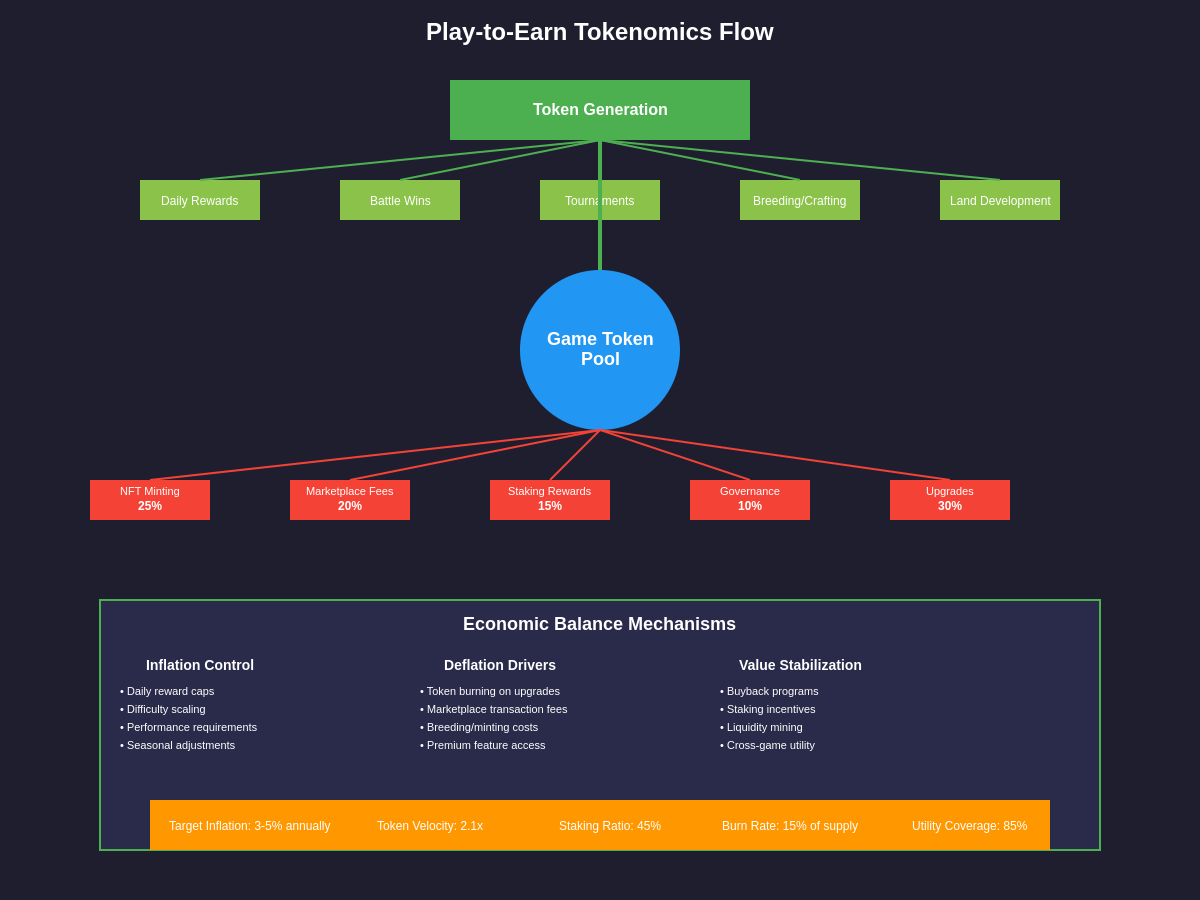
Effective tokenomics design requires careful consideration of multiple factors including token utility, distribution mechanisms, inflationary and deflationary pressures, governance rights, and long-term sustainability incentives. Most successful play-to-earn games implement dual-token systems where one token serves as the primary reward currency with higher inflation rates, while another token provides governance rights and value accrual with more limited supply. This separation allows games to maintain engaging reward systems while protecting long-term token holder value.
Reward distribution mechanisms vary significantly across different games but generally include daily quest completion rewards, player-versus-player battle winnings, tournament prize pools, breeding and crafting success bonuses, land and asset development returns, and seasonal event participation rewards. The most sustainable games create multiple reward pathways that cater to different player preferences and skill levels, ensuring that both casual and hardcore players can find profitable activities within the ecosystem.
Staking mechanisms play crucial roles in many play-to-earn tokenomics by creating additional utility for native tokens while providing passive income opportunities for long-term holders. These systems often require players to stake tokens to access certain game features, participate in governance decisions, or earn bonus rewards from various activities. Staking also helps reduce circulating token supply, creating deflationary pressure that can support token value appreciation over time.
NFT Marketplaces and Trading Ecosystems
Gaming NFT marketplaces have evolved into sophisticated trading platforms that support complex asset discovery, price analysis, and transaction execution for digital gaming assets. These marketplaces typically feature advanced filtering and search capabilities, detailed asset analytics including price history and rarity rankings, integrated wallet connectivity for seamless transactions, and community features like wishlists and social trading capabilities. Traders analyzing NFT gaming asset price trends and market opportunities rely on these platforms for market intelligence and execution capabilities.
The pricing dynamics of gaming NFTs depend on multiple factors including functional utility within games, rarity and aesthetic appeal, historical performance and earning potential, market sentiment and community perception, and broader cryptocurrency market conditions. Unlike traditional collectible NFTs that derive value primarily from artistic or cultural significance, gaming NFTs must demonstrate clear utility and income-generating potential to maintain sustainable valuations.
Cross-marketplace arbitrage opportunities have emerged as sophisticated traders identify price discrepancies for identical or similar assets across different platforms. These activities help improve market efficiency while creating additional revenue streams for active participants who monitor multiple marketplaces and maintain sufficient liquidity to capitalize on temporary price imbalances.
The Rise of Gaming Metaverses and Virtual Economies
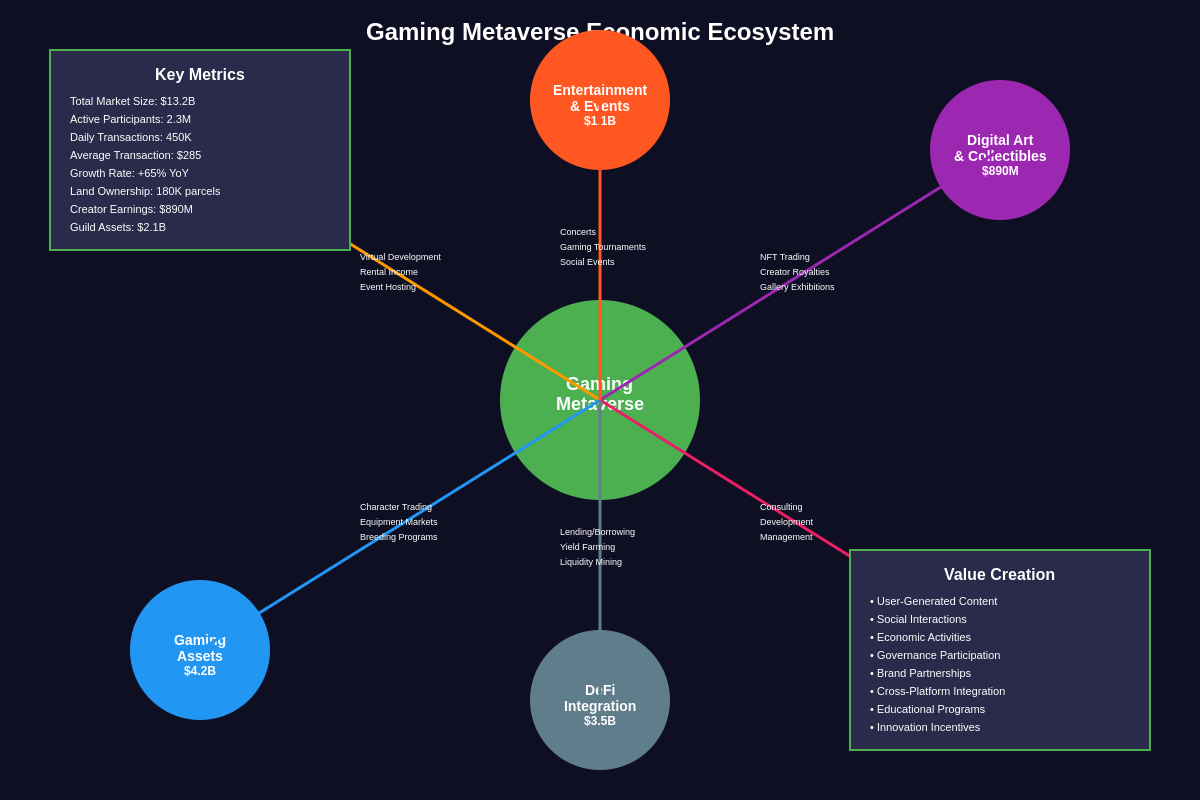
Gaming metaverses represent the convergence of gaming, social interaction, economic activity, and digital asset ownership within persistent virtual worlds that operate continuously regardless of individual player participation. These environments support complex economic interactions including real estate development, business creation, employment opportunities, educational activities, and cultural events that blur the boundaries between gaming and real-world economic participation.
Virtual land ownership has become a significant component of gaming metaverse economics, with prime locations in popular worlds selling for hundreds of thousands or even millions of dollars. Land owners can develop their parcels with custom buildings, experiences, and businesses that generate ongoing revenue through various mechanisms including rental income, event hosting, advertising placements, and transaction fees from commercial activities.
The social aspects of gaming metaverses create additional economic opportunities through community building, content creation, event organization, and service provision. Players can establish businesses providing architectural services, event planning, marketing support, or educational content that serves other participants within the virtual world. These activities demonstrate how gaming metaverses are evolving beyond pure entertainment into comprehensive economic ecosystems.
Challenges and Criticisms of Play-to-Earn Models
Sustainability concerns represent one of the most significant challenges facing play-to-earn gaming models, as many projects struggle to maintain token values and player engagement over extended periods. The fundamental tension between rewarding players with valuable tokens and maintaining those tokens’ value through scarcity creates complex economic dynamics that many projects have not successfully navigated. Critics argue that many play-to-earn games resemble Ponzi schemes where early participants profit at the expense of later entrants, particularly when new player acquisition slows and reward token prices decline.
Gameplay quality often suffers in play-to-earn games where economic incentives overshadow entertainment value, leading to repetitive grinding mechanics that prioritize reward generation over engaging player experiences. This focus on earning potential can create games that feel more like work than entertainment, potentially limiting their appeal to mainstream gaming audiences who prioritize fun and engagement over financial returns. The challenge for developers is creating games that successfully balance economic incentives with compelling gameplay experiences.
Regulatory uncertainty poses ongoing challenges for play-to-earn gaming projects, particularly regarding token classification, taxation requirements, gambling regulations, and consumer protection standards. Different jurisdictions are developing varying approaches to blockchain gaming regulation, creating compliance complexities for global gaming projects and potential access restrictions for players in certain regions.
Environmental Impact and Sustainability Considerations
The environmental impact of blockchain gaming has become an increasingly important consideration as the industry scales and attracts mainstream attention. While earlier NFT gaming projects relied heavily on energy-intensive proof-of-work blockchains like Ethereum, many newer projects have migrated to more energy-efficient proof-of-stake networks or specialized gaming blockchains designed for lower environmental impact. Layer 2 solutions and sidechains also help reduce the environmental footprint of gaming transactions while maintaining security and decentralization benefits.
Carbon offset programs and renewable energy initiatives have been adopted by several major gaming NFT projects as part of their sustainability commitments. These efforts include partnerships with verified carbon credit providers, investment in renewable energy projects, and support for environmental conservation initiatives that help neutralize the carbon footprint of blockchain gaming activities.
The development of more efficient blockchain technologies specifically designed for gaming applications continues to address environmental concerns while providing better user experiences through faster transaction speeds and lower costs. Projects like Immutable X, Polygon, and WAX have positioned themselves as environmentally conscious alternatives that maintain the benefits of blockchain gaming while minimizing ecological impact.
Integration with Traditional Gaming Platforms
The integration of blockchain elements into traditional gaming platforms represents a significant opportunity for mainstream adoption of gaming NFTs and play-to-earn mechanics. Major gaming companies including Ubisoft, Square Enix, and Electronic Arts have announced various blockchain gaming initiatives, though implementation has proceeded more cautiously than initially anticipated due to technical challenges and community feedback concerns.
Platform compatibility and user experience considerations remain significant barriers to widespread adoption, as current blockchain gaming interfaces often require technical knowledge that mainstream gamers lack. Successful integration efforts focus on abstracting blockchain complexity while preserving the ownership and earning benefits that make these systems valuable to players.
Cross-platform asset portability represents a long-term goal that could significantly increase the value proposition of gaming NFTs by allowing players to use their digital assets across multiple games and platforms. While technical and business model challenges currently limit such integration, ongoing development of standards and protocols may eventually enable seamless asset interoperability.
Regional Adoption and Economic Impact
The geographic distribution of play-to-earn gaming adoption reveals interesting patterns related to economic opportunity, technological infrastructure, and regulatory environments. Southeast Asian countries, particularly the Philippines and Indonesia, have emerged as major centers of play-to-earn activity due to favorable combinations of gaming culture, economic incentives, and supportive community structures that have facilitated rapid adoption.
Latin American countries including Venezuela, Brazil, and Argentina have also seen significant play-to-earn adoption, often driven by economic conditions that make gaming income particularly attractive compared to traditional employment opportunities. The ability to earn stable cryptocurrency income through gaming has provided economic stability for many participants in regions experiencing currency devaluation or limited job opportunities.
The creation of gaming-focused economic zones and regulatory frameworks in countries like Singapore, Switzerland, and the United Arab Emirates demonstrates how governments are recognizing and supporting the economic potential of blockchain gaming industries. These initiatives provide regulatory clarity, tax incentives, and infrastructure support that encourage gaming companies to establish operations and create local employment opportunities.
Technology Infrastructure and Scaling Solutions
The technical infrastructure supporting gaming NFTs and play-to-earn models continues to evolve rapidly as developers address scalability, user experience, and cost challenges that have limited mainstream adoption. Layer 2 scaling solutions like Polygon, Arbitrum, and Optimism provide faster transaction speeds and lower costs while maintaining compatibility with existing Ethereum-based gaming ecosystems. Investors tracking blockchain gaming infrastructure developments and scaling solutions monitor these technological improvements for investment opportunities.
Specialized gaming blockchains designed specifically for gaming applications offer optimized performance characteristics including high transaction throughput, low latency, and gaming-specific features like built-in marketplace functionality and asset management tools. Networks like Flow, WAX, and Ronin have demonstrated the benefits of purpose-built gaming infrastructure while maintaining sufficient decentralization and security for valuable digital assets.
Interoperability protocols and standards development efforts aim to create seamless connections between different gaming ecosystems, enabling true cross-game asset utility and reducing platform dependency risks for both players and developers. Projects like Enjin’s ERC-1155 standard and emerging cross-chain bridge technologies provide foundations for more connected gaming experiences.
Developer Economics and Business Models
The economic models available to gaming developers in the NFT and play-to-earn space differ significantly from traditional gaming monetization approaches, offering new revenue streams while creating different risk and investment profiles. Initial NFT sales can provide substantial upfront funding for game development, while ongoing marketplace transaction fees create sustainable revenue streams that align developer incentives with ecosystem health and activity levels.
Token allocation strategies for gaming projects typically reserve significant portions of total token supply for development funding, team compensation, community rewards, and ecosystem development initiatives. The distribution and vesting schedules for these tokens significantly impact project economics and long-term sustainability, requiring careful balance between immediate funding needs and long-term value preservation.
Partnership opportunities with guilds, content creators, and technology providers create additional revenue and growth channels for gaming projects while distributing risks and leveraging specialized expertise. These collaborative approaches often prove more sustainable than purely independent development efforts, particularly for smaller teams with limited resources.
Community Building and Social Dynamics
Community development represents a critical success factor for gaming NFT projects, as engaged and active player communities drive adoption, create network effects, and provide valuable feedback for ongoing development efforts. Successful projects invest heavily in community management, social media engagement, educational content creation, and player support services that foster positive community dynamics and encourage long-term participation.
Social gaming elements including guilds, tournaments, collaborative events, and community governance mechanisms help create stronger connections between players while providing additional engagement and retention mechanisms beyond pure economic incentives. These social features often prove essential for maintaining player interest during periods of reduced economic returns or market volatility.
Content creation and streaming ecosystems around gaming NFT projects provide additional marketing and community building benefits while creating economic opportunities for influencers and content creators who can monetize their audience engagement through sponsorships, affiliate programs, and direct community support mechanisms.
Future Trends and Industry Evolution
The evolution of gaming NFTs and play-to-earn models continues to accelerate as technology improvements, regulatory clarity, and mainstream adoption create new opportunities and challenges for industry participants. Artificial intelligence integration promises to enhance game mechanics, personalize player experiences, and optimize economic systems through dynamic difficulty adjustment and intelligent reward distribution algorithms.
Virtual and augmented reality integration with blockchain gaming represents a significant frontier that could dramatically enhance immersion and value creation opportunities within gaming metaverses. As VR and AR hardware becomes more accessible and powerful, the combination with blockchain-based asset ownership and play-to-earn mechanics could create unprecedented gaming experiences.
The convergence of gaming with decentralized finance protocols creates opportunities for more sophisticated economic interactions including lending and borrowing of gaming assets, yield farming with game tokens, and complex financial derivatives based on gaming performance and asset values. Professional traders and institutional investors utilize comprehensive market analysis platforms to evaluate these emerging financial products and identify strategic opportunities in the evolving gaming economy.
The transformation of gaming through NFTs and play-to-earn models represents more than a technological innovation; it signifies a fundamental shift toward more equitable value distribution in digital entertainment. As these systems mature and overcome current limitations, they promise to create sustainable economic opportunities for millions of participants while pioneering new forms of digital ownership and community organization. The success of this transformation will ultimately depend on the industry’s ability to balance economic incentives with engaging gameplay experiences while addressing sustainability, regulatory, and accessibility challenges that currently limit mainstream adoption.
The future of gaming NFTs and play-to-earn models will likely involve greater integration with traditional gaming experiences, improved sustainability mechanisms, enhanced interoperability across platforms, and more sophisticated economic models that can support diverse player preferences and skill levels. As these technologies continue to evolve, they will undoubtedly reshape not only how we think about gaming but also how we understand digital ownership, virtual economies, and the relationship between entertainment and economic opportunity in an increasingly digital world.
Disclaimer: This article is for educational and informational purposes only and should not be construed as financial advice. Gaming NFTs and play-to-earn investments carry significant risks, including the potential for total loss of capital. The gaming NFT market is highly volatile and speculative, with many projects failing to maintain long-term value or sustainability. Regulatory frameworks for blockchain gaming continue to evolve and may impact project viability and user access. Always conduct your own research and consult with qualified financial advisors before making investment decisions. The author and publisher are not responsible for any financial losses that may occur from acting on the information provided in this article.